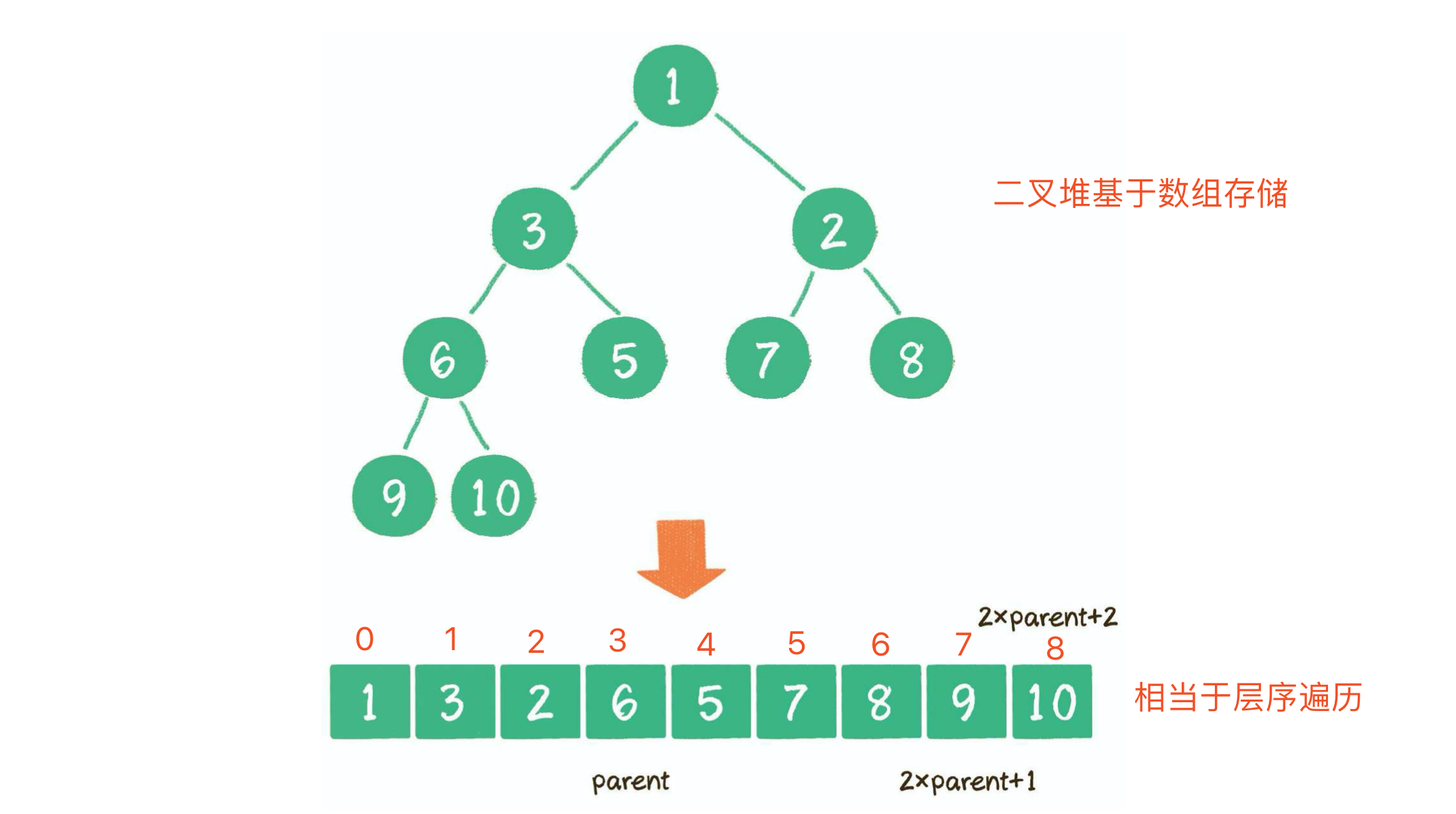概述
- 二叉堆本质上是完全二叉树,分最大堆和最小堆。
- 最大堆的任何一个父节点的值,都大于或等于它左右孩子节点的值。
- 最小堆的任何一个父节点的值,都小于或等于它左右孩子节点的值。
- 二叉堆的根节点叫做堆顶。
构建二叉堆
- 堆的插入操作是单一节点的上浮。
- 堆的删除操作是单一节点的下沉。
- 二叉堆的物理存储方式基于数组。

二叉堆代码实现
1
2
3
4
5
6
7
8
9
10
11
12
13
14
15
16
17
18
19
20
21
22
23
24
25
26
27
28
29
30
31
32
33
34
35
36
37
38
39
40
41
42
43
44
45
46
47
48
49
50
51
| public class Heap {
public static void upAdjust(int[] array) {
int childIndex = array.length - 1;
int parentIndex = (childIndex-1)/2;
int temp = array[childIndex];
while (childIndex>0 && temp<array[parentIndex]) {
array[childIndex] = array[parentIndex];
childIndex = parentIndex;
parentIndex = (parentIndex-1)/2;
}
array[childIndex] = temp;
}
public static void downAdjust(int[] array, int parentIndex, int length) {
int temp = array[parentIndex];
int childIndex = 2*parentIndex+1;
while (childIndex<length) {
if (childIndex+1<length&&array[childIndex+1]<array[childIndex]) {
childIndex++;
}
if (temp<array[childIndex]) {
break;
}
array[parentIndex] = array[childIndex];
parentIndex = childIndex;
childIndex=2*childIndex+1;
}
array[parentIndex]=temp;
}
public static void buildHeap(int[] array) {
for (int i=(array.length-2)/2; i>=0; i--) {
downAdjust(array, i, array.length);
}
}
public static void main(String[] args) {
int[] array = new int[]{1,3,2,6,5,7,8,9,10,0};
upAdjust(array);
System.out.printf(Arrays.toString(array));
array = new int[]{1,3,2,6,5,7,8,9,10,0};
buildHeap(array);
System.out.printf(Arrays.toString(array));
}
}
|
堆排序
1
2
3
4
5
6
7
8
9
10
11
12
13
14
15
16
17
18
19
20
21
22
23
24
25
26
27
28
29
30
31
32
33
34
35
36
37
38
39
40
41
42
43
44
45
46
47
48
49
50
51
52
53
54
55
56
| public class HeapSort {
public static void heapAdjust(int[] arr, int parent, int length) {
int temp = arr[parent];
int child = parent * 2 + 1;
while (child < length) {
if (child + 1 < length && arr[child] < arr[child + 1]) {
child++;
}
if(temp>arr[child]){
break;
}else {
arr[parent]=arr[child];
parent=child;
child=child *2+1;
}
}
arr[parent]=temp;
}
public static void sort(int[] list){
for (int i = list.length/2; i >=0 ; i--) {
heapAdjust(list,i,list.length);
}
for (int i = list.length-1; i >0; i--) {
int temp=list[i];
list[i]=list[0];
list[0]=temp;
heapAdjust(list,0,i);
}
}
public static void main(String[] args) {
int[] arr=new int[]{5,6,3,1,8,7,2,4};
sort(arr);
System.out.println(Arrays.toString(arr));
}
}
|
TopN问题求解
题目描述
有一个 1GB 大小的文件,文件里每一行是一个词,每个词的大小不超过 16B,内存大小限制是 1MB,要求返回频数最高的 100 个词(Top 100)。
解答思路
由于内存限制,我们依然无法直接将大文件的所有词一次读到内存中。因此,同样可以采用分治策略,把一个大文件分解成多个小文件,保证每个文件的大小小于 1MB,进而直接将单个小文件读取到内存中进行处理。
思路如下
首先遍历大文件,对遍历到的每个词x,执行 hash(x) % 5000,将结果为 i 的词存放到文件 ai 中。遍历结束后,我们可以得到 5000 个小文件。每个小文件的大小为 200KB 左右。如果有的小文件大小仍然超过 1MB,则采用同样的方式继续进行分解。
接着统计每个小文件中出现频数最高的 100 个词。最简单的方式是使用 HashMap 来实现。其中 key 为词,value 为该词出现的频率。具体方法是:对于遍历到的词 x,如果在 map 中不存在,则执行 map.put(x, 1);若存在,则执行 map.put(x, map.get(x)+1),将该词频数加 1。
上面我们统计了每个小文件单词出现的频数。接下来,我们可以通过维护一个小顶堆来找出所有词中出现频数最高的 100 个。具体方法是:依次遍历每个小文件,构建一个小顶堆,堆大小为 100。如果遍历到的词的出现次数大于堆顶词的出现次数,则用新词替换堆顶的词,然后重新调整为小顶堆,遍历结束后,小顶堆上的词就是出现频数最高的 100 个词。
(即删除当前最小堆顶元素,留下100个)
方法总结
分而治之,进行哈希取余;
使用 HashMap 统计频数;
求解最大的 TopN 个,用小顶堆;求解最小的 TopN 个,用大顶堆。
下集预告
今日内容整理自网络。后期将会抽时间出一个实战系列。包括SpringCloud、docker、k8s、jenkins、prometheus等集开发、测试、部署、运维流程的笔记。



